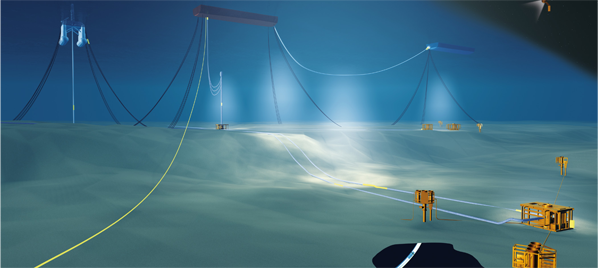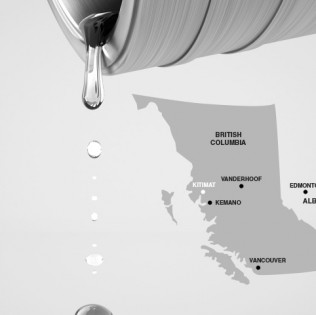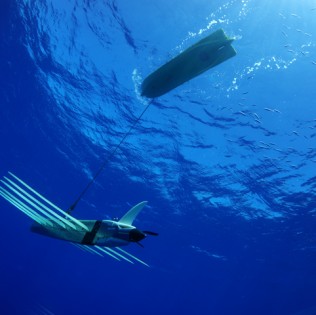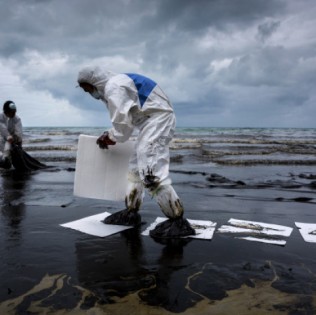by TheOGM
| No comment
Published on August 11th, 2010
Innovative Subsea Surveillance
The subsea environment poses a set of technological challenges unlike anything that the surface can present.
As in the planning of any asset development, the decision-making process attempts to maximize asset value and to minimize costs without compromising safety and reliability. The cost analysis focuses on capital expenditures and operating expenses, and it also includes risks, or the potential costs of unforeseen events. The conditions driving these costs are numerous and interrelated, and they include reservoir-related factors including existing infrastructure, water depth, weather and currents, seabed conditions, cost of construction and decommissioning of permanent structures, time to first production, equipment reliability, well accessibility for future monitoring or intervention, and flow assurance – the ability to keep fluids flowing in the lines.
Subsea Development Drivers
The value of using subsea technology depends on how actual production volumes are meeting the expected/planned targets. High reliability performance of the subsea production system is of utmost importance to ensure production availability. System downtime can severely affect the project economics. The project economics can no longer accept over-engineered solutions that focus on ruling out absolutely any system risks from a flow assurance or a mechanical design point of view. The production assurance risks must be partially managed through operations rather than relying on over-conservative designs, resulting in high capex impact.
Monitoring Technology
Subsea infrastructure can be monitored to reduce technical risks in deepwater subsea developments. A number of different sensors may be utilized, depending on the requirements. Hi-tech fiber- optic sensors are also available for either discrete or distributed applications.
Discrete Monitoring
Discrete sensors can be used to monitor the integrity of specific parts of the subsea infrastructure. For example, vortex-induced vibrations in risers can be monitored using sensors that provide direct strain measurements.
Pressure, shape, and buckle monitoring are also possible with the discrete fiber-optic sensor system:
- Accurate, real-time curvature, axial strain, hoop strain, and temperature measurements
- Over 100 discrete measurement points along a single optical fiber
- Robust, nonintrusive pressure sensors
- Easily retrofitted by divers or remotely operated vehicles
Distributed Monitoring
Distributed-measurement applications may include leak detection through temperature monitoring and impact surveillance through vibration monitoring.
- Real-time distributed temperature, strain, and vibration measurements
- Distributed measurement along up to 100 km of pipeline
- Pumped installation of long fibers for efficient installation, improved reliability, and elimination of optical connectors
Flow Assurance Monitoring
A major production system selection consideration is flow assurance. It is linked to the anticipated characteristics of the produced fluids and the planned production processing system. Production disruptions caused by erosion, wax or asphaltene deposits or plugging caused by hydrates can have severe consequences to the project. Slug identification and management are also important considerations affecting the selected production system, usually dealt with through restriction to minimum flow or flow boosting.
Process and flow assurance simulators are available to assist in the selection of the optimized production system. Flow assurance considerations are often the most influential factors on how to produce the subsea field and will indirectly affect the production system and technology selection. Flow assurance is a continuous and evolving activity throughout the producing phase. The flow assurance model is often used for scenario predictions calibrated to actual production data.
Integrity Monitoring
While generally not directly affecting production rates, mechanical integrity management is the key component for enhancing production uptime and availability. Typical components of the integrity management workflow include monitoring of corrosion, erosion and fatigue of subsea assets as well as inspecting the overall integrity of the system (e.g., leaks, breaks, insulation cracks, etc). An advanced approach to integrity surveillance includes monitoring of various parameters along the subsea infrastructure (vibration, fatigue, wall loss, wire breakage and annulus flooding for flexible, etc).
A properly defined integrity monitoring program allows verification of the analytical assumptions about the interaction between structures and environment and provides real-life verification of asset response to the loading to which it is subject.
The subsea surveillance system must be engineered to accommodate the data acquisition philosophy (what, why, when, where, how), and include the corresponding hardware (sensors), power, and IT infrastructure. To ensure that measurements will be available, when required, especially later in the asset’s lifecycle, the subsea surveillance system must be detailed and engineered prior to the deployment of the subsea system. Retrofit is often too risky and costly, precluding any changes or additions after the initial system deployment.
The necessity of monitoring fluid flow and infrastructure to ensure optimized production, flow assurance and asset integrity will gain much more importance as subsea installation activities move to new and more critical environments.
Did you enjoy this article?


 Canada’s Liquefied Natural Gas Potential
Canada’s Liquefied Natural Gas Potential Autonomous Marine Vehicles [Liquid Robotics]
Autonomous Marine Vehicles [Liquid Robotics] Risk Reduction With Marine Institute Offshore Simulator
Risk Reduction With Marine Institute Offshore Simulator Surveying The Road To Project Success
Surveying The Road To Project Success The Revival of the Gulf Coast, USA
The Revival of the Gulf Coast, USA.jpg)
